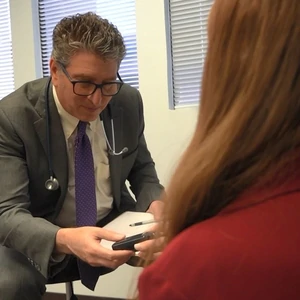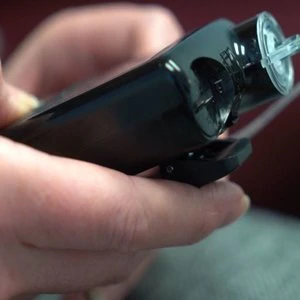How Innovation Unlocked New Diabetes Data
With the advancement in technology, a new metric is emerging within diabetes management – Time in Range.
Looking into the eyes of parents with a newly-diagnosed child, Dr. Kevin Kaiserman knows how difficult conversations about diabetes can be.
With care, he explains the burden of the disease — the finger pricks, the carb counting, the constant monitoring, the sleepless nights.
“Most of the work lies on their shoulders,” he says. “Oftentimes, it’s the parents who have to interpret numbers, make critical decisions – essentially take on all of the care.”
But these conversations are starting to sound different.
“I am more hopeful today,” he says. “We are seeing outcomes we didn’t think were possible.”
Kaiserman, a pediatric endocrinologist in Los Angeles, California, has practiced in the diabetes space since the mid-90s. He’s seen the rapid rate of innovation around diabetes management, and believes new technology is giving patients greater freedom. But it’s more than that. Medical technology is uncovering data that is changing how diabetes is managed by Kaiserman, his patients and so many individuals who are living with diabetes.
I am more hopeful today. We are seeing outcomes we didn’t think were possible.
Dr. Kevin KaisermanPediatric Endocrinologist
A NEW METRIC IS UNCOVERED
For decades, the A1C test was the best way to measure blood sugar for people living with diabetes, and globally it remains the most common blood test to determine how well patients are managing their Type 1 or Type 2 diabetes. The A1C test reflects a person’s average blood sugar level for the past three months and can measure what percentage of their hemoglobin — a protein in red blood cells that carries oxygen — is coated with sugar. On average, the higher the A1C level, the higher the risk for complications.
But in 1999, advancements in the industry unveiled a new technology: continuous glucose monitors. These systems — often referred to as CGMs — allow patients to check real-time glucose readings with help from a tiny, wearable sensor.
At the time, no one knew what CGMs would eventually uncover.
With the data collected by CGMs, clinical investigators and physicians began to look at a new way to measure how well a person was managing their disease. Over the years, a new metric was forming — Time in Range.
“The industry started to study it within the last 10 years,” says Dr. Robert Vigersky, Chief Medical Officer at Medtronic Diabetes. “There has been a confluence of observations in the literature and an improved accuracy of CGM technology which got us to this point.”
“Time in Range” goes beyond the traditional A1C test. It provides visibility into high and low glucose levels throughout the day. Today’s CGMs can report glucose readings every five minutes. That’s 288 real-time readings every day and a much different approach than A1C testing.
“CGM technology makes this metric feasible,” says Dr. Vigersky. “A1C is a great marker for overall control, but it represents an average of glucose. Being an average, it misses some of the key features of hyperglycemia and hypoglycemia because you can’t see that in an average.”
In recent years, the diabetes research community reached a consensus that between 70mg/dl (low) and 180 mg/dl (high) is the optimal Time in Range for individuals managing their diabetes. When a patient’s blood sugar goes too high or too low it can feel frustrating and sometimes difficult to take action with a snack, exercise or a bolus of insulin, which can further perpetuate the negative cycle of lows and highs.
The more a patient stays within this range, the better they’ll feel and the risk of hyperglycemic or hypoglycemic events decreases.
For Dr. Kaiserman’s practice, it’s an opportunity to help patients feel more empowered in their day-to-day disease management.
“Before we had CGMs, you just had a static number and had no idea whether that number represented a rapid rise, fall, or a stable glucose number,” he says. “Now, you have the opportunity to know if you’re rising or falling and we can help make better therapy decisions together.”
And since patients can view their Time in Range in real time they can make decisions to intervene and prevent going high or low.
In 2019, Medtronic released real-world outcomes for their MiniMed 670G™ system, which includes the Guardian™ Sensor 3 that measures an individual blood sugar levels every five minutes. Data on nearly eight million patient days1 showed an average Time in Range of 71 percent across all age groups. On average, people using the advanced features of the system, known as SmartGuard™ Auto Mode, experienced 2.3 additional hours of Time in Range per day, compared to individuals in Manual Mode. This represents 35 additional days a year that a person with diabetes is spending in a healthy range.*
And that range can make a difference.
WARNING: Medtronic performed an evaluation of the MiniMed™ 670G system and determined that it may not be safe for use in children under the age of 7 because of the way that the system is designed and the daily insulin requirements. Therefore this device should not be used in anyone under the age of 7 years old. This device should also not be used in patients who require less than a total daily insulin dose of 8 units per day because the device requires a minimum of 8 units per day to operate safely.
AVOIDING COMPLICATIONS – AND COST
In a recent study led by Dr. Vigersky, researchers looked at the correlation between Time in Range and A1C. If they can find a link between these two measurements, that could make Time in Range an even more meaningful metric.
Why? Research continues to find that as Time in Range changes, so does A1C. Dr. Vigersky found that with every 10 percent change in Time in Range, there is an approximate 0.8 percent shift in A1C.2
“That’s important, because we know controlled A1C numbers decrease the risk of complications,” says Dr. Vigersky. “And if a good time in range mean a better A1C, we can connect all three together — Time in Range, A1C, and risk of complications.”3
The findings help reinforce that a change is underway in how physicians care for their patients and another way to avoid long-term complications, which can be devastating and costly. Diabetes remains the leading cause of acquired blindness, kidney failure, non-traumatic amputations, and serious vascular issues like heart failure.
“And that’s where the cost of diabetes is,” says Dr. Kaiserman. “If we can introduce these new technologies with new ways of measuring success, there’s an upfront cost, but the back-end savings is beyond calculation.”
Keeping patients in better glucose control for longer periods of time can not only reduce complications but could provide a ripple effect throughout healthcare.
“Payers want A1C numbers every three or four months,” says Vigersky. “That requires doctor or laboratory visits, but what if we could do away with those visits?”
Additionally, doctors have access to a new set of data that can be accessed anytime, anywhere.
“We have tools that distill the information down for us,” says Kaiserman. “I can look at a patient’s numbers and help strategize new ways to improve their management.”
That’s my charge to the medical technology industry – don’t stop innovating.
Dr. Robert VigerskyChief Medical Officer, Medtronic Diabetes
‘THESE ARE EXCITING TIMES’
In Dr. Kaiserman’s office, he’s incorporated a new message for patients and their families: the future is bright.
“These are exciting times,” he says. “The rapid rate of innovation in diabetes care is incredible and patients are seeing better Time in Range, a better quality of life, and fewer complications.”
And the rapid rate isn’t over yet.
“The next frontier is the automation of technology,” he says. “Someday, there will be CGMs that do all of the decision making behind the scenes.”
That day may be closer than we think.
“We’ll get there,” says Dr. Vigersky. “And that’s my charge to the medical technology industry – don’t stop innovating.”
IMPORTANT SAFETY INFORMATION
The MiniMed™ 670G System
The Medtronic MiniMed™ 670G system is intended for continuous delivery of basal insulin (at user selectable rates) and administration of insulin boluses (in user selectable amounts) for the management of type 1 diabetes mellitus in persons, seven years of age and older, requiring insulin as well as for the continuous monitoring and trending of glucose levels in the fluid under the skin. The MiniMed™ 670G system includes SmartGuard™ technology, which can be programmed to automatically adjust delivery of basal insulin based on Continuous Glucose Monitor sensor glucose values and can suspend delivery of insulin when the sensor glucose value falls below or is predicted to fall below predefined threshold values. The system requires a prescription. The Guardian™ Sensor (3) glucose values are not intended to be used directly for making therapy adjustments, but rather to provide an indication of when a fingerstick may be required. A confirmatory finger stick test via the CONTOUR®NEXT LINK 2.4 blood glucose meter is required prior to making adjustments to diabetes therapy. All therapy adjustments should be based on measurements obtained using the CONTOUR®NEXT LINK 2.4 blood glucose meter and not on values provided by the Guardian™ Sensor (3). Always check the pump display to ensure the glucose result shown agrees with the glucose results shown on the CONTOUR®NEXT LINK 2.4 blood glucose meter. Do not calibrate your CGM device or calculate a bolus using a blood glucose meter result taken from an Alternative Site (palm) or from a control solution test. It is not recommended to calibrate your CGM device when sensor or blood glucose values are changing rapidly, e.g., following a meal or physical exercise. If a control solution test is out of range, please note that the result may be transmitted to your pump when in the “Always” send mode.
WARNING: Medtronic performed an evaluation of the MiniMed™ 670G system and determined that it may not be safe for use in children under the age of 7 because of the way that the system is designed and the daily insulin requirements. Therefore this device should not be used in anyone under the age of 7 years old. This device should also not be used in patients who require less than a total daily insulin dose of 8 units per day because the device requires a minimum of 8 units per day to operate safely.
Pump therapy is not recommended for people whose vision or hearing does not allow recognition of pump signals and alarms. Pump therapy is not recommended for people who are unwilling or unable to maintain contact with their healthcare professional. The safety of the MiniMed™ 670G system has not been studied in pregnant women. For complete details of the system, including product and important safety information such as indications, contraindications, warnings and precautions associated with system and its components, please consult http://www.medtronicdiabetes.com/important-safety-information#minimed-670g and the appropriate user guide at http://www.medtronicdiabetes.com/download-library.
The Guardian™ Connect System
The Guardian™ Connect system requires a prescription and is indicated for continuous or periodic monitoring of glucose levels in the interstitial fluid under the skin, in patients (14 to 75 years of age) with diabetes mellitus. The system is intended to complement, not replace, information obtained from standard blood glucose monitoring devices, and is not recommended for people who are unwilling or unable to perform a minimum of two meter blood glucose tests per day, or for people who are unable or unwilling to maintain contact with their healthcare professional. The system requires a functioning mobile electronic device with correct settings. If the mobile device is not set up or used correctly, you may not receive sensor glucose information or alerts. For complete details of the system and its components, including warnings, contraindications, and precautions, please consult the user guide at http://www.medtronicdiabetes.com/support/download-library/user-guides and www.medtronicdiabetes.com/importantsafetyinformation.
L001



